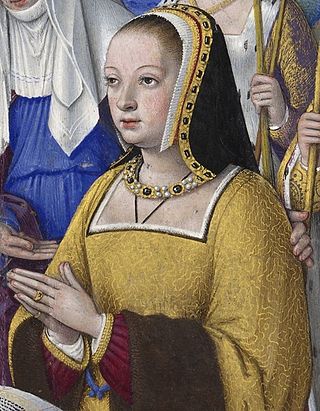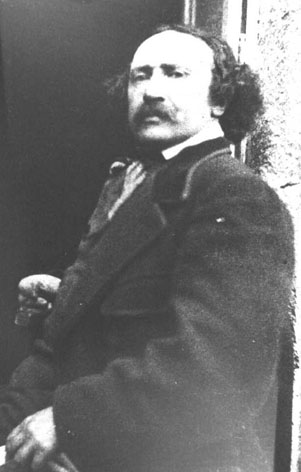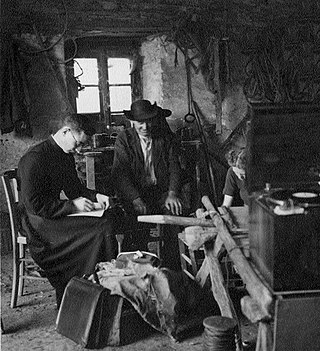
Anne of Brittany was reigning Duchess of Brittany from 1488 until her death, and Queen of France from 1491 to 1498 and from 1499 to her death. She was the only woman to have been queen consort of France twice. During the Italian Wars, Anne also became Queen of Naples, from 1501 to 1504, and Duchess of Milan, in 1499–1500 and from 1500 to 1512.

The House of Rohan is a Breton family of viscounts, later dukes and princes in the French nobility, coming from the locality of Rohan in Brittany. Their line descends from the viscounts of Porhoët and is said to trace back to the legendary Conan Meriadoc. Through the Porhoët, the Rohan are related to the Dukes of Brittany, with whom the family intermingled again after its inception. During the Middle Ages, it was one of the most powerful families in the Duchy of Brittany. They developed ties with the French and English royal houses as well, and played an important role in French and European history.

Breton literature may refer to literature in the Breton language (Brezhoneg) or the broader literary tradition of Brittany in the three other main languages of the area, namely, Latin, Gallo and French – all of which have had strong mutual linguistic and cultural influences.
Bernard Le Nail was a French writer and Breton militant. After studying commerce in Paris, he headed the promotional office of the Chamber of Commerce and Industry in Nantes. In 1979 he became Secretary General of the Comité d'Etude et de Liaison des Intérêts Bretons (CELIB) at Lanester. Between 1983 and 2000 he was director of the Cultural Institute of Brittany and had an important role in the conception and publication of the collection Les Bretons au-delà des mers : Explorateurs et grands voyageurs. He was also involved in the conception and publication of the following works: 500 Bretons à connaître, revising the Guide Bleu Bretagne, Guides Gallimard Bretagne, Les noms qui ont fait l’histoire de Bretagne, Dictionnaire des femmes en Bretagne, La Bretagne entre Armor et Argoat.

Paul Sébillot was a French folklorist, painter, and writer. Many of his works are about his native province, Brittany.

Princess Belle-Etoile is a French literary fairy tale written by Madame d'Aulnoy. Her source for the tale was Ancilotto, King of Provino, by Giovanni Francesco Straparola.
Morgens, morgans, or mari-morgans are Welsh and Breton water spirits that drown men.

François-Marie Luzel, often known by his Breton name Fañch an Uhel, was a French folklorist and Breton-language poet.

Anatole le Braz, the "Bard of Brittany", was a Breton poet, folklore collector and translator. He was highly regarded amongst both European and American scholars, and known for his warmth and charm.
Adolphe Yves Marie Le Goaziou was a bookseller, publisher and member of the French Resistance in wartime Brittany.

François Falc'hun was a French linguist known for his theories about the origin of the Breton language. He was also an ordained Canon in the Catholic clergy.
Pierre Denis, known also as Pêr Denez, was a French linguist, lexicographer, scholar and writer.
"An Alarc'h" is a Breton traditional song. It is found in the 1839 collection Barzaz Breiz. It tells of the return from exile in England of the Breton prince Jean de Montfort and his defeat of the French army under Bertrand du Guesclin in 1379. It has been recorded by, amongst others, Alan Stivell and Gilles Servat.
The Order of the Ermine was originally a chivalric order of the 14th and 15th centuries in the Duchy of Brittany. The ermine is the emblem of Brittany. In the 20th century, it was revived by the Cultural Institute of Brittany as an honor for those contributing to Breton culture. It was created in 1972 to honor those who contribute to Breton culture and development. At its head is a Chancellor and two vice-chancellors: Riwanon Kervella and André Lavanant. The siege is at the Institut Culturel de Bretagne, the castle of the Ermine, Vannes.

A groac'h is a kind of Breton water-fairy. Seen in various forms, often by night, many are old, similar to ogres and witches, sometimes with walrus teeth. Supposed to live in caverns, under the beach and under the sea, the groac'h has power over the forces of nature and can change its shape. It is mainly known as a malevolent figure, largely because of Émile Souvestre's story La Groac'h de l'île du Lok, in which the fairy seduces men, changes them into fish and serves them as meals to her guests, on one of the Glénan Islands. Other tales present them as old solitary fairies who can overwhelm with gifts the humans who visit them.
Morvarc'h is the name of a fabulous horse of Breton legend found in two folktales reworked in the 19th and 20th centuries. Though its name appears in older sources, it was invented or reinterpreted by Charles Guyot, who named it Morvark in his version of the legend of the city of Ys in 1926. It belongs to the "Queen of the North" Malgven, who gives it to her husband King Gradlon. Endowed with the ability to gallop on the waves, Morvarc'h is described as having a black coat and as breathing flames through its nostrils. It also appears in a Breton folktale about King Marc'h of Cornouaille. In the course of a deer hunt it is killed by its own rider's arrow, which has been turned around by the spell of Dahud, the daughter of Malgven. She then puts the ears of the horse Morvarc'h on the head of King Marc'h, who seeks in vain to hide them.

Donatien Laurent was a French musicologist and linguist.
Lucien Gourong was a French writer, singer, and storyteller.









